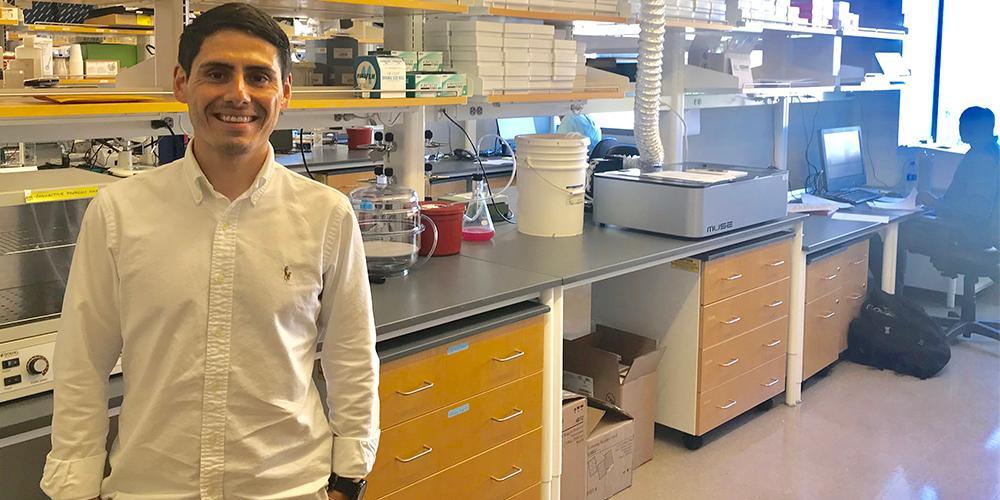
Upstate Medical University’s Samuel Herberg, PhD, assistant professor in the Center for Vision Research and the Department of Ophthalmology and Visual Sciences, has been named the recipient of the 2024 Douglas H. Johnson Award for Glaucoma Research. The award, from the BrightFocus Foundation is presented annually to the top-rated proposal in the National Glaucoma Research program. The award is given in recognition of exceptionally promising and forward-thinking ideas in the field of glaucoma research.
Building on his lab’s previous success developing bioengineered models of key tissues to study eye disease, Herberg will use this grant to investigate the mechanisms that cause glaucoma.
Herberg spent the majority of his graduate and postdoctoral research career focusing on musculoskeletal tissue regeneration, studying cartilage and bone. While at Wake Forest he completed a year of cancer research, learning more about disease modeling using patient-derived cells and 3-dimensional biopolymer hydrogels. When he and his wife, ophthalmologist Preethi Ganapathy, MD, PhD, were looking for a place to settle, they came up with the idea to combine their expertise.
“What if we replaced the cancer cells in the 3D hydrogels with ocular cells; what could we test that’s not known?” Herberg asked. “We came here and sold [CVR Director] Dr. Brunken on this idea that maybe it’s worth taking a risk with somebody who has no experience in the eye but has tools and skills that nobody else here had before we came.”
In 2018 they got to work, with Herberg running the labs and Ganapathy splitting her time between patients and research. Herberg’s lab quickly produced results from their unique approach.
“Most labs use 2D and hard materials like plastic and glass because those are good for imaging and are relatively cheap to manufacture, but what we’re dealing with in the eye are relatively soft tissues. So why would we culture these cells that we isolate from donor eyes in a completely artificial, overly stiff environment and expect them to do what they do normally?” Herberg says some cells exhibited completely different behavior between the traditional 2D and 3D hydrogel models. “We could visualize the difference and we could make more sense of the findings.”
Herberg will be using this BrightFocus award to apply his 3D modeling technique to two parts of the eye called the trabecular meshwork (TM) and Schlemm’s canal, structures that help maintain normal eye pressure via controlled fluid damage. While the exact cause of glaucoma, a blinding disease that impacts three million Americans, isn’t known, it’s been linked to high eye pressure and biomechanical alterations.
“The disease mechanisms are not well understood. This, in part, because most in vitro studies on TM and Schlemm’s canal cells have been conducted separately; in such experiments you can’t really ask how one cell type talks to the other,” says Herberg. “The purpose of this grant was to bring the two cells back together in a very controlled environment that resembles the native tissues—in both health and disease. It’s plausible, and highly likely, that with glaucoma TM becomes impaired first, subsequently affecting the Schlemm’s canal, simply because the fluid goes through it first.”
The biggest barrier to this research is obtaining the cells themselves, explains Herberg.
“Our innovative approach to studying Schlemm’s canal cell mechanobiology is likely why this proposal was rated highly; these cells cannot be purchased; we have to isolate them from human donor material using a very challenging technique.” He and his lab learned this technique from the world leader in the field. “It’s very frustrating; the success rate can be as low as 10%. But we were persistent. We have isolated quite a few of these cells that we are now able to share with other labs as well, so that is extremely satisfying.”
Center for Vision Research Director William Brunken, PhD, thinks Herberg brings a fresh perspective to the field of vision research.
“The field of glaucoma research has been stuck for over a decade now; we still don’t know why the disease happens,” Brunken said. “Somebody from outside the field who isn’t locked into the conventional thinking can look at the same problem from a different perspective and bring fresh insights and great innovation—that’s exactly what Herberg has done spectacularly well.”
Herberg and Ganapathy’s gamble on a joint lab venture seems to have paid off.
“We have learned things that we didn’t know six years ago, and we have followed our interests. I was fascinated with biomechanics not only as an essential contributor to tissue development, but also to healing. This whole grant is really about mechanobiology; we believe that mechanobiology, or the impairment of these processes, has a substantial role in glaucoma.”
Learn more about Herberg’s lab here, and Ganapathy’s lab here.
For more about vision research at Upstate, visit https://www.upstate.edu/cvr
–by Kayla Richmond
